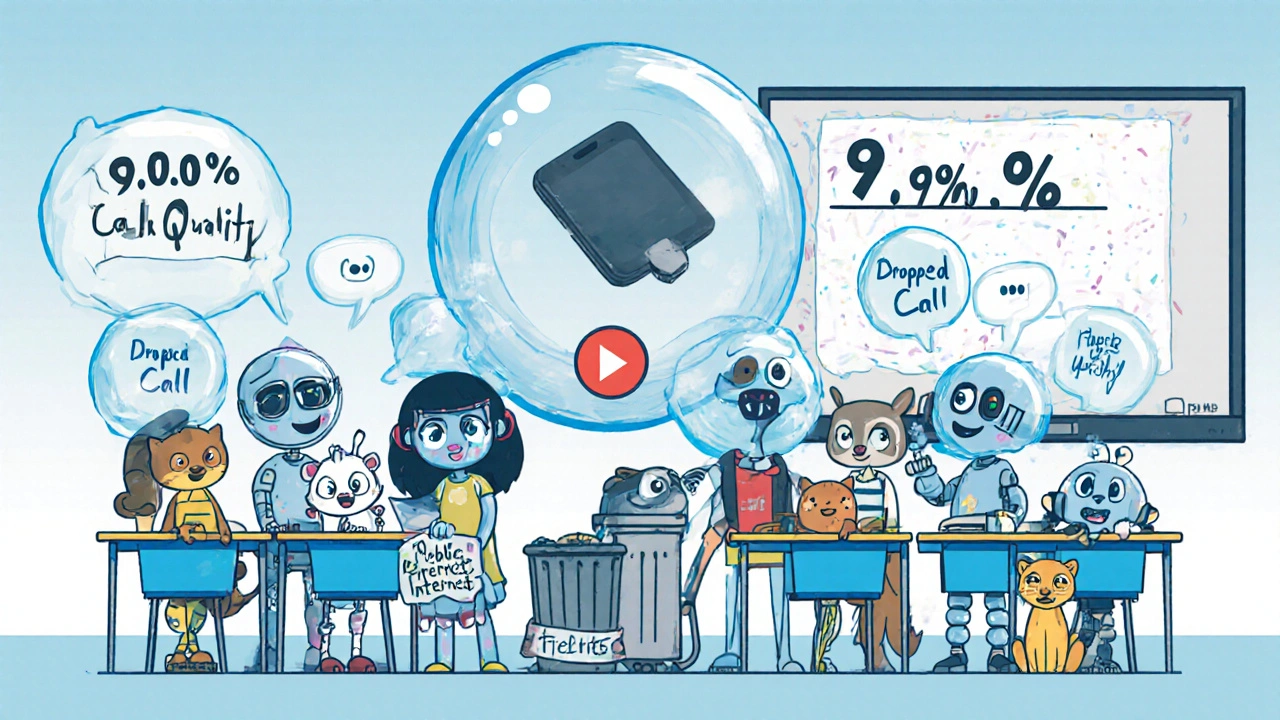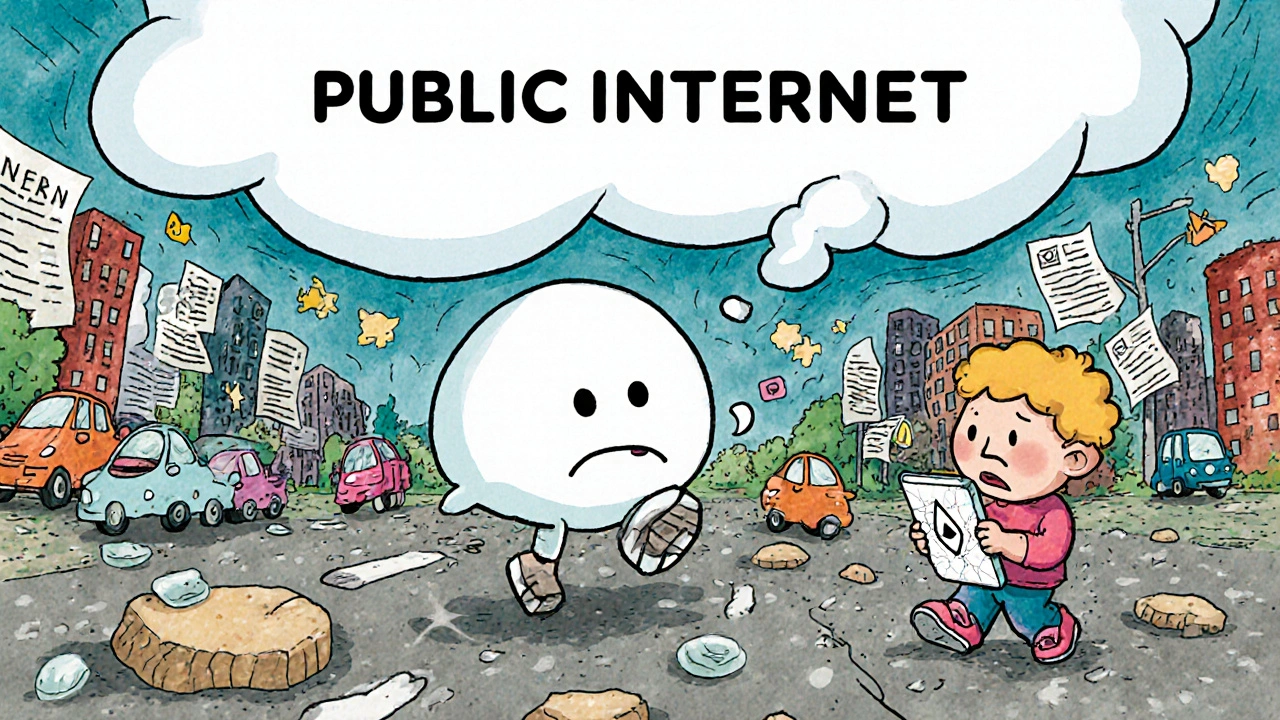When your business depends on crystal-clear phone calls over the internet, the path your voice data takes isn’t just a technical detail-it’s the difference between a smooth conversation and a call that drops, echoes, or cuts out mid-sentence. If you’re using VoIP for customer service, remote teams, or emergency communications, you’re already dealing with the reality that public internet paths are unpredictable. That’s why more companies are turning to cloud peering solutions like AWS Direct Connect, Azure ExpressRoute, and Google Cloud Interconnect. But are they worth the cost and complexity? Let’s break down what actually changes when you move from the public internet to a private, direct connection.
Why Public Internet Isn’t Good Enough for VoIP
The public internet was never built for real-time voice. It’s a shared highway where every packet-whether it’s your email, a YouTube video, or your voice call-competes for space. During peak hours, traffic jams happen. Packets get delayed, reordered, or lost. For VoIP, this isn’t just annoying-it’s destructive. A typical public internet VoIP call experiences 45-90ms of latency. That’s the time it takes for your voice to reach the other person. Sounds fine? Now add jitter-the variation in that delay. On public internet, jitter can swing between 15ms and 50ms during business hours. Human ears notice anything above 30ms. The result? Robotic voices, gaps in conversation, and dropped calls. Packet loss is even worse. On public internet, you can expect 0.1% to 5% packet loss during congestion. For VoIP, even 1% loss means noticeable audio dropouts. Google Cloud’s own data shows direct connections maintain packet loss below 0.01%. That’s 100 times better. And it’s not just quality-it’s reliability. Gartner found enterprises using public internet for VoIP experience 3.2 times more dropped calls during business hours than those on direct connections. If your call center handles 1,000 calls a day, that’s 150+ dropped calls daily on public internet. On a direct path? Maybe one or two.What Is Cloud Peering? Direct Connect, ExpressRoute, Interconnect
Cloud peering isn’t magic. It’s physical. Instead of sending your VoIP traffic across the open internet, you connect your office or data center directly to a cloud provider’s network through a dedicated fiber link. Think of it like building a private tunnel from your building to a data center, instead of using public roads. AWS Direct Connect, Azure ExpressRoute, and Google Cloud Interconnect all do the same thing: bypass the public internet. They use dedicated ports-1 Gbps, 10 Gbps, or even 100 Gbps-to carry your traffic. This isn’t a software setting. It’s hardware. Your data never touches the public internet. That means no congestion, no third-party routing, no unpredictable delays. Here’s what that looks like in practice:- AWS Direct Connect: Connects to one of their 130+ locations worldwide. Offers 1 Gbps to 100 Gbps. Used by 35% of enterprise customers for mission-critical apps as of 2022.
- Azure ExpressRoute: Provides 2 Gbps to 100 Gbps circuits with a 99.95% SLA. Introduced ExpressRoute Local in 2023 for regional VoIP with guaranteed 2ms latency.
- Google Cloud Interconnect: Offers 10 Gbps or 100 Gbps connections. Reports 40% year-over-year growth in adoption. Used by Teladoc Health to achieve 99.995% VoIP uptime across 15,000 users.
Performance Comparison: Direct Connect vs Public Internet
Let’s compare the numbers side by side. These aren’t theoretical claims-they’re based on real-world benchmarks from CoreSite, PacketFabric, and provider documentation updated through 2023.| Metric | Direct Connect (AWS/Azure/Google) | Public Internet |
|---|---|---|
| Latency | 15-25ms | 45-90ms |
| Jitter | 1-2ms | 15-50ms |
| Packet Loss | <0.01% | 0.1%-5% |
| Uptime SLA | 99.99%-99.995% | No SLA |
| Call Quality Consistency | 99.999% | 92.7% |
That 99.999% call quality number? That’s from Megaport’s case study with a telecom provider. On public internet, they saw nearly 7% of calls suffer from quality issues. On Direct Connect? Less than 0.01%. That’s not a minor improvement-it’s the difference between a professional service and a broken one.

Security: Why Physical Separation Matters
VoIP carries sensitive data. Patient consultations, financial calls, HR conversations-all of it travels over the network. Public internet VoIP relies on encryption like SRTP and TLS. That’s good, but it’s not enough. Direct connections eliminate the exposure entirely. Your traffic never leaves the private network. There’s no chance for man-in-the-middle attacks, packet sniffing, or BGP hijacking. Lightpath Fiber’s 2023 study found direct connections reduce exposure to these attacks by 99.8% compared to public internet. HIPAA and PCI DSS compliance are easier too. The updated HIPAA guidelines from January 2023 explicitly recommend private network connections for healthcare communications. If you’re in healthcare, finance, or any regulated industry, this isn’t optional-it’s a requirement.Costs and Setup: Is It Worth It?
Yes, direct connections cost more. But cost isn’t just about the monthly bill. It’s about downtime, lost productivity, and customer trust. AWS Direct Connect pricing as of January 2024 is $0.30 per hour for a 1 Gbps port, plus $0.115 per GB of data transfer. That sounds expensive until you compare it to the hidden costs of public internet: unpredictable egress fees, lost sales from dropped calls, and IT time spent troubleshooting echo and latency. Setup is another hurdle. You need to:- Locate a colocation facility near your office
- Coordinate with your ISP for a cross-connect
- Install compatible hardware (Cisco ASR 1000, Juniper MX series)
- Configure BGP routing with proper ASNs (64512-65534 for Google)
- Apply QoS policies to prioritize RTP traffic with DSCP EF marking
Who Should Use Direct Connect? Who Should Stick with Public Internet?
This isn’t a one-size-fits-all decision. Use Direct Connect if:- You have 100+ concurrent VoIP users
- You’re in healthcare, finance, or government (HIPAA/PCI DSS)
- Your VoIP system is mission-critical (call centers, emergency services)
- You’re using UCaaS platforms like Zoom or Microsoft Teams at scale
- You’ve had consistent quality issues on public internet
- You have fewer than 50 concurrent calls
- Your budget is tight and downtime isn’t catastrophic
- You’ve implemented strong QoS on your local network
- You’re using VoIP for internal, non-critical communication

Real-World Successes and Failures
The data tells a clear story. A Reddit user named Mark Thompson migrated his 500-user VoIP system from public internet to AWS Direct Connect. Dropped calls fell from 8.7% to 0.3%. Echo complaints vanished. Teladoc Health, serving 15,000 users, boosted VoIP uptime from 99.2% to 99.995% using Google Cloud Interconnect. But failures happen too. One healthcare provider lost 22 hours of VoIP service after misconfiguring Azure ExpressRoute’s BGP routes. No failover. No monitoring. Just silence. The lesson? Direct connections are powerful-but only if configured right. Poor setup can be worse than public internet.The Future: AI, Multi-Cloud, and Integrated VoIP
The market is moving fast. AWS announced “Voice-Optimized Direct Connect” at re:Invent 2023-using machine learning to predict congestion and auto-prioritize voice traffic. It’s scheduled for Q2 2024. Google Cloud updated its Interconnect SLA in October 2023 to guarantee under 1ms jitter and 0.001% packet loss for voice traffic. And multi-cloud is here. Enterprises aren’t picking one provider anymore. 62% plan to use hybrid direct connections across AWS, Azure, and Google by 2025. That means solutions like AWS Direct Connect Gateway and Azure Virtual WAN are becoming essential for routing voice traffic across clouds without touching the public internet. VoIP platforms like Zoom and Microsoft Teams now offer native integrations with these direct connections. That means better performance out of the box.Final Decision: Is It Right for You?
If your VoIP system is a core part of your business-customer service, sales, operations, or compliance-then the public internet is a gamble. The risks aren’t just technical. They’re financial and reputational. Direct connections cost more upfront. They take longer to set up. But they deliver reliability that public internet can’t match. For businesses with 100+ users or strict compliance needs, the choice is clear. For smaller teams? Optimize your QoS. Use a business-grade router. Prioritize RTP traffic. Monitor your jitter. You might not need a fiber tunnel-just better control over what you already have. The right path isn’t about technology. It’s about risk tolerance. If one dropped call could cost you a customer, a contract, or even a life-then don’t risk the public internet. Build your own lane.Is Direct Connect faster than public internet for VoIP?
Yes, significantly. Direct Connect reduces latency from 45-90ms on public internet to 15-25ms. Jitter drops from 15-50ms to under 2ms. Packet loss falls from up to 5% to less than 0.01%. These differences make voice calls clearer, more reliable, and free of echoes or dropouts.
How much does AWS Direct Connect cost for VoIP?
As of January 2024, AWS charges $0.30 per hour for a 1 Gbps Direct Connect port, plus $0.115 per GB of data transferred. Setup costs range from $3,000 to $10,000 for colocation and cross-connects. For a 500-user VoIP system, monthly costs are typically $1,200-$2,500, depending on bandwidth and data usage.
Do I need a data center to use Direct Connect?
Yes. You must colocate your network equipment in a facility approved by the cloud provider-like AWS Direct Connect locations, Google Cloud interconnection points, or Azure ExpressRoute partners. These are usually third-party data centers near your office. You can’t install Direct Connect from your home or office network.
Can I use Direct Connect with Microsoft Teams or Zoom?
Yes. Both Zoom and Microsoft Teams announced native integrations with AWS Direct Connect, Azure ExpressRoute, and Google Cloud Interconnect in Q4 2023. This means your VoIP traffic from these platforms can travel directly over private fiber, bypassing the public internet entirely.
What’s the biggest mistake companies make with Direct Connect?
Failing to configure BGP routing and QoS properly. Many companies set up the physical connection but forget to prioritize VoIP traffic (RTP packets with DSCP EF marking) or set up failover routes. This leads to outages when a single link fails. Training and testing are critical.
Is Direct Connect better than SD-WAN for VoIP?
They solve different problems. SD-WAN optimizes traffic over multiple public internet links using intelligent routing. Direct Connect replaces public internet entirely with a private fiber link. For high-volume, mission-critical VoIP, Direct Connect is more reliable. For smaller offices with mixed traffic, SD-WAN with QoS is a cost-effective alternative.
